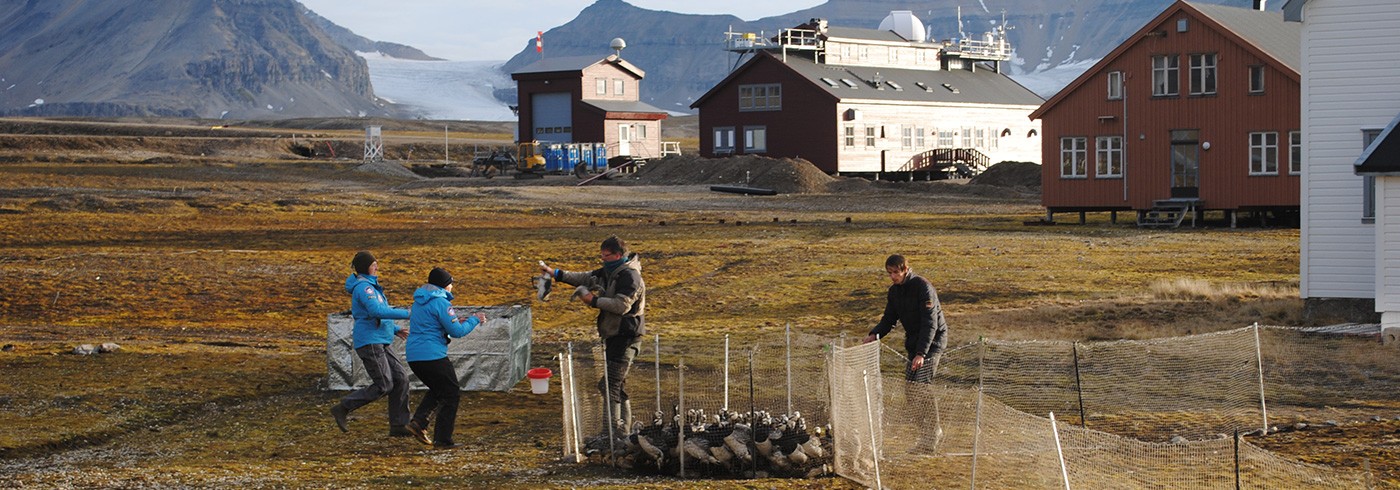My initial interest in Ny-Ålesund arose while researching the ways in which non-Arctic states construct themselves as legitimate stakeholders in Arctic affairs. The repeated references by would-be Artic Council observer states – such as China, India, Italy, Japan and South Korea (which have all been recently granted permanent observer status) – to the national science stations they have established near the 79th parallel in Ny-Ålesund seemed to infuse this small Svalbard community with a geopolitical significance unusual, to say the least, for a village with a population that fluctuates from 30 in the winter to about 150 during the height of the summer research season.
What I encountered during the week I spent there this summer was a remarkable social environment ensconced within a high technology landscape of scientific infrastructure and instruments distributed amidst the modest wooden houses of Ny-Ålesund’s previous incarnation as a mining settlement. Flanking the village are the cultural heritage remains of tragedy, triumph and folly: on the southern outskirts beneath Zeppelin Mountain are the blackened earth and rock and tangled iron remains of the Kings Bay coal mine, closed in 1963 after an explosion took the lives of 21 miners; to the east looms the launch tower of the airship Norge, which passed over the North Pole in 1926; and on an island across Kongsfjorden from Ny-Ålesund, the industrial artifacts of a marble quarry rust in peace precisely where they were left 100 years ago when ‘New London’ was abandoned after only two years in operation.
The practice of science dictates the contemporary agenda of Ny-Ålesund, and activity there today is prioritized accordingly. Communication through wireless networks, which disturb the array of sensitive instruments monitoring meteorological and atmospheric phenomena, is prohibited. Physical space is also managed for scientific and environmental ends; much of the village, for instance, is designated as bird sanctuary and off limits to humans (except for the biologists, mostly from the Netherlands station, who have long studied the barnacle geese that descend upon Svalbard in the summer). Despite the scores of signs that restrict and regulate the behavior of the diverse scientists and other visitors that circulate through Ny-Ålesund, egalitarian and communal social norms prevail: all are expected to submit to the Svalbard custom of removing shoes indoors; the entire village dines together at the local mess hall; and the entrance to every building is always kept unlocked (though the latter is largely motivated as a means of escape in the case of a chance encounter with a polar bear, several of which were observed in and around Ny-Ålesund the week I was there).
Considering the prominence of the science stations in political rhetoric, I expected to discern a surfeit of national symbols in the built environment of Ny-Ålesund. Yet flags and other outward expressions of state affiliation were subdued and almost invisible in most cases (the twin stone lions guarding the entrance to China’s Yellow River Station notwithstanding). Scientists for the most part wore nondescript clothing that did not identify their national origin. Thus, while geopolitics may represent a primary motivation for the governments of non-Arctic states maintaining science stations on Svalbard, local manifestations of national presence are not overly apparent.
Another striking characteristic of Ny-Ålesund is the spectrum of scientific activity practiced there, and the vastly different types of work the disparate disciplines entail. The Dutch biological research on barnacle geese, for example, requires extensive human effort in following and monitoring, and occasionally corralling and conducting experiments upon, the flocks that scurry through the center of the village. By contrast, the Italian station, during the particular week I spent in Ny-Ålesund, was operated by a single researcher who maintained a multitude of sophisticated instruments situated on the edge of town, generating atmospheric data that is sent back to Italy for real time analysis and application in global climate models.
Witnessing this diversity in methods and spatial scales – from the hands-on and local to the remote and global – led me to reflect on my own approach to assessing Arctic futures from a historical and political standpoint. Much of my work, taking place at 60 degrees north in Stockholm, involves analyzing documents, scouring public statements, and reading reports and other literature that might provide some insight into how the future of the Arctic has been perceived and produced over time. Spending a week in the High Arctic among natural scientists – observing their work, moving about in the built environment, visiting the stations and interviewing various officials and researchers – has reminded me that field work can be an invaluable experience and crucial aspect of social as well as natural science. This is especially true when seeking to understand a particular place the likes of Ny-Ålesund, and for grasping the subtleties and multiple meanings of this fascinating community that is at the geographic periphery of civilization but at the very center of the increasingly globalized Arctic.
Eric Paglia, KTH Royal Institute of Technology


